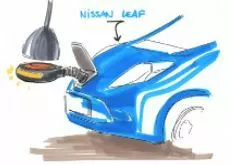President Biden recently announced a new target which aims to reduce US greenhouse gas pollution from 2005 levels by 50-52 percent by 2030. The transportation sector is the United States’ largest contributor to greenhouse gas emissions, and the magnified focus on electric vehicle (EV) charging is not a coincidence.
In order to achieve this goal, President Biden is looking to provide funding for charging infrastructures that could help reduce greenhouse gas pollution as well as creating jobs. But what are electric vehicles and how do they work?
EVs use one or more electric motors powered by rechargeable lithium-ion batteries; if they sound familiar, they are the same kind of batteries that power your smartphones and laptops. Just like your electric devices, EVs need to plug into an external power source for charging after being depleted.
Just like stopping at a gas station for a standard car, a network of charging stations gives EV batteries access to power for the road. Because EVs do not rely on fossil fuels, most do not emit any carbon dioxide emissions (CO2), which greatly reduces air pollution.
Here are some ways EV charging contributes to our goal of reducing greenhouse gas pollution in half:
Electric Vehicles can produce no tailpipe emissions.
Traditional engines utilize the combustion of gasoline or diesel which creates energy at the cost of generating harmful carbon emissions. Full electric vehicles do not even need a tailpipe as their batteries create no emission at all. Lithium-ion is the most common type of battery which can be depleted and charged repeatedly without contributing to air pollution.
Production of EV Battery is getting cleaner.
While electric vehicles may not contribute much to air pollution while on the road, the production of their batteries has been an issue in the past. Due to EVs being a contemporary piece of technology, there have been inconsistent standards that have caused large carbon footprints with the production of their batteries. Manufacturers of EVs are now setting regulations for battery suppliers which require renewable energy sources during production. Now, EV battery’s carbon footprint is 2-3 times lower than just two years ago.
Clean after production.
While most emissions generated from EVs are produced during battery manufacturing, standard vehicles continue to produce CO2emissions every time they are on the road. On average, a gasoline-powered vehicle produces between 4-5 metric tons of CO2 per year. With millions of gas-powered vehicles being driven around the world, greenhouse emissions continue to be produced exponentially. While this is continuing to deteriorate the environment around us, electric vehicles are powered by renewable energy which maintains a neutral carbon footprint.
With the newly established target of cutting greenhouse gases by 2030, it’s no secret that electric vehicles could be the key to help us achieve our goal.
Westfalia has recently announced the launch of their fully automated EV charging capabilities in conjunction with GULPLUG, a company that accelerates the energy transition and clean mobility.

Here is a broad description of Westfalia’s patent-pending EV charging process for an Automated Parking System (APS):
- Once an EV is parked with a transfer area, an adapter is inserted into the EV’s charging port and, if required, the adaptor connection surface is orientated upwards.
- The EV is either taken directly to an EV charging position within the APS or later during the EV’s designated time within the APS.
- Once the EV is located in an EV charging position, the cable end connector is automatically lowered to the adapter’s connection surface
- The electrical connection between the cable end connector and adaptor is made and the EV begins charging.
- At the end of the charging process, the cable end connector and adaptor are disconnected and the cable end connector is raised to its home position and is now ready to charge another EV.
